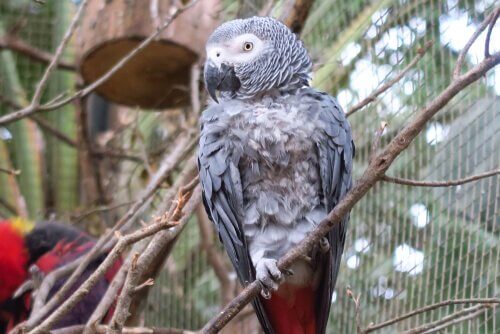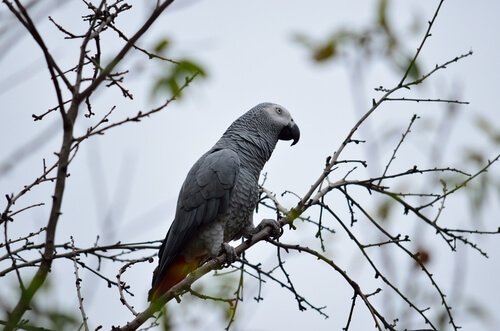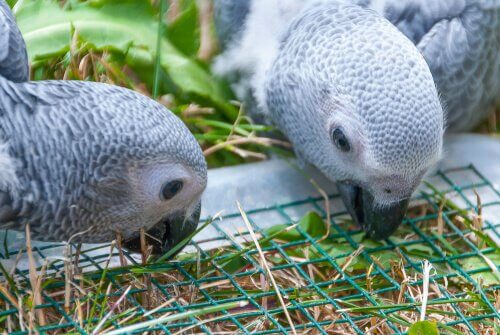Grey Parrots: What You Need to Know before You Get One

Grey parrots are African birds, with a very high level of intelligence. They can memorize and repeat words. In this article, we’ll tell you everything you need to know about this animal.
These birds are members of the Psittacidae family and are native to African countries such as Gabon, Guinea, Tanzania, Uganda, and Kenya. Furthermore, they’re officially in danger of extinction there, due to poaching and the human destruction of their native forests.
Regarding their physical characteristics, as their name suggests, the body of the grey parrot or Psittacus erithacus mainly has gray feathers. The exception here is their black-bill, the tip of their tail (which is red), and their face, which is whitish around the eyes.
More characteristics of grey parrots

This is a medium-sized parrot, which can measure up to 16 inches and weigh about a pound. Sexual dimorphism is definitely present in this species, as the females are slightly smaller and lighter than the males.
Even though the males of this species seem to have a more solid appearance, you can’t really tell their gender just by looking at them. However, you can definitely tell their age as the young ones have darker feathers throughout. The tip of their tail also turns a reddish color towards the beginning of their reproductive stage.
In their natural habitat, grey parrots live in flocks of hundreds of individuals who are organized by hierarchy. These birds are monogamous and mate for life and their successful reproduction depends on specific climate conditions.
They build their nests in tree hollows and the females lay from two to five eggs, and then incubate them for about a month.
Implications of having grey parrots as a pet

In both the European Union and the United States, the commercialization of the grey parrot is prohibited if captured directly from its natural environment. 20% of the current population of these birds are the result of illegal trading.
There are many breeding farms, where they separate them from their parents as soon as they’re born. For that reason, they’ll imprint on humans rather than on their parents.
A grey parrot is not recommended as a pet in households where there are small children. This is because their hooked beaks can easily injure them, albeit unintentionally. In addition, the bird’s claws are usually sharp and they can hurt you.
Having a grey parrot is more like having a child than a pet. This is because they require attention 24 hours a day. You can’t just leave them on their own for too long.
You must keep in mind that this is a wild animal and that it was removed from its natural habitat. In the wild, it would cohabit with many other birds of its kind. That’s why you should adopt them as pairs, a couple, so they can start their own family.
The proper selection of a cage
The location of a cage for grey parrots should have plenty of natural light, and should be placed away from noisy environments. It shouldn’t be in the kitchen. Furthermore, it should be big enough for them to be able to make short flights while in it. So, the minimum measurements of a cage should be 7 feet long by 7 feet wide by 7 feet high.
You should also allow them to leave their cage for at least two hours every day. This way they can roam around and investigate at their own leisure. Do be careful because they’ll peck on everything they come across. You can take advantage of their time outside a cage to clean it thoroughly and thus avoid odors and proliferation of diseases.
An intelligent and sensitive creature, the grey parrot will fall into depression if their affection is unrequited. An even more curious fact in relation to this bird is that they can capture the feelings, energy, moods, and thoughts of the people around them. They’re capable of establishing a very close bond with humans.
And, of course, you can’t ignore the fact that they’re excellent imitators. They can easily reproduce a human voice, both single words and complete phrases. This means you’ll have someone to have fun (albeit senseless) conversations with.
All cited sources were thoroughly reviewed by our team to ensure their quality, reliability, currency, and validity. The bibliography of this article was considered reliable and of academic or scientific accuracy.
- Péron, F., Rat-Fischer, L., Lalot, M., Nagle, L., & Bovet, D. (2011). Cooperative problem solving in African grey parrots (Psittacus erithacus). Animal Cognition. https://doi.org/10.1007/s10071-011-0389-2